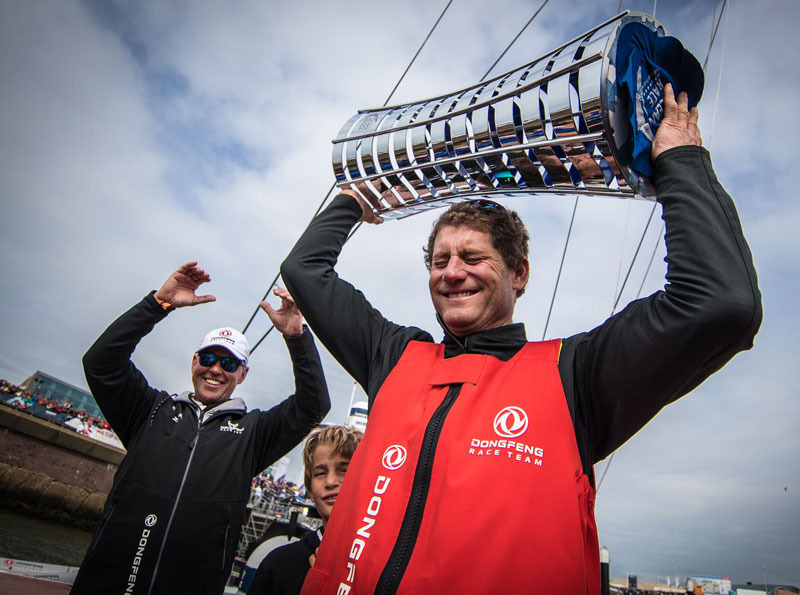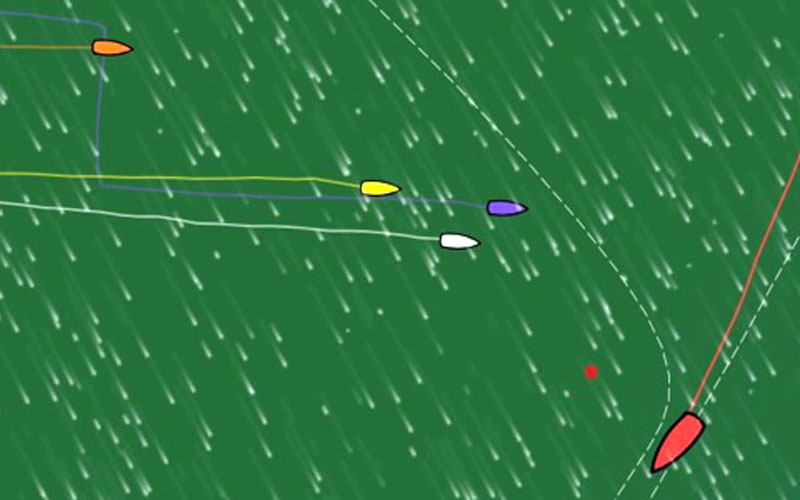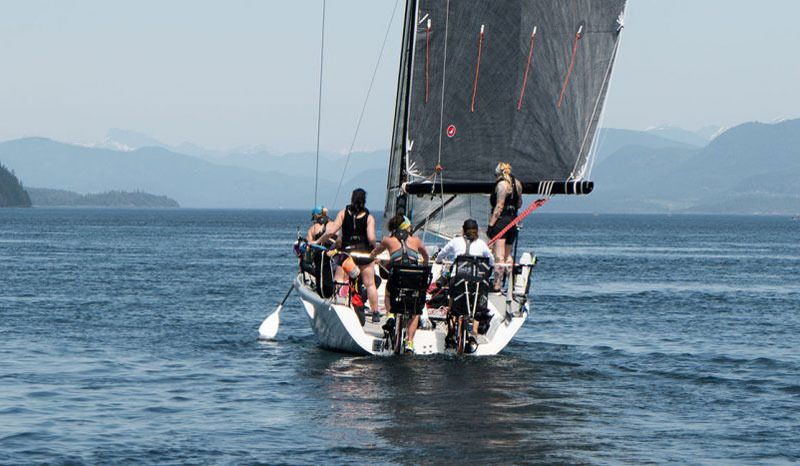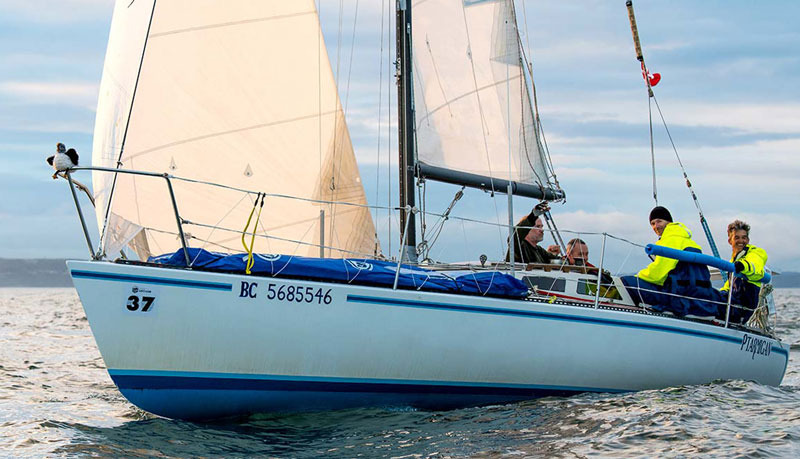
Singlehanders on Their Way to Hanalei
In the age of insanely tall skyscrapers and self-driving cars it’s nice to know that a San Francisco tradition is still around and unchanged since 1978. On Saturday the start of the Singlehanded Sailing Society’s Singlehanded TransPac was off and running with 19 diverse boats heading to Hanalei, Kauai.

© Latitude 38 Media, LLC
The slow boats started first off the Corinthian Yacht Club race deck in a gentle southwesterly, which built to the mid-teens by the Golden Gate. At the skippers’ meeting on Friday, veteran SHTP racer Skip Allan gave tactics and weather advice with a simple theme: “Go west as fast as you can.” The threat of a Southerly Surge was predicted with a possibility of a wind hole forming just west of the Farallones.

Twenty hours after the start that hole did form, trapping the slower boats and allowing only three to escape unharmed. As they rapidly separate from the rest of the fleet, Charlie Casey on the Cal 40 Riff Rider, Tom Boussie on the Capo 30 JouJou and Don Martin on his Wyliecat 30 Crinan II now lead the others on a wild ride in 30 knots of wind headed for Hawaii.

© Latitude 38 Media, LLC
The hole is dissipating and the other boats are now getting the breeze they need to fight back, and have plenty of time to make gains on the leaders. Grégory Saramite on the Mini 6.5 Libra had to turn around and head to Sausalito with autopilot troubles and decided to retire. Mike Jefferson on his aluminum Garcia Passoa 47 Mouton Noir also headed back with electronic troubles and water ingress from a leaky hatch. And Gary Burton on Elizabeth Ann, a Brookings, OR-based Westsail 32 has announced he has retired from the race and is heading to Bodega Bay, no doubt having caught a ride on the Southerly Surge.

© Latitude 38 Media, LLC
Good luck to them all. Readers can follow along at www.sfbaysss.org/shtp2018. We’ll have regular updates in ‘Lectronic Latitude, and a full race report in the August issue of Latitude 38.
A Flyer Clinches Volvo Ocean Race

The Volvo Ocean Race has arrived at its closest finish in the race’s long and storied history. After starting the final ‘sprint’ leg with three teams tied on points, one expected a thrilling three-way match race to the finish, possibly coming down to the wire in The Hague, the one-design Volvo 65s having provided unbelievably close racing all the way around the world. The anticipated match race wasn’t to be however, instead replaced by one of the most remarkable ‘flyers’ of all time, where one boat broke decisively from her rivals in a high-risk move, only to pull off an improbable win right at the finish. In a twist at the end of a race that has been full of them, Dongfeng has won the Volvo Ocean Race in their second attempt. French skipper Charles Caudrelier can now add this victory to his win six years earlier with Groupama.

Since departing Gothenburg, Sweden, on Thursday and sailing a circuitous 970-mile course that included a mark right off Aarhus, Demnark, the fleet had endured two days of intense, close-quarters sailing before they were finally rumbling down the coast of western Denmark toward the finish line in The Hague, Netherlands. Conventional wisdom would have been to take the offshore route, and to stay with rivals MAPFRE and Team Brunel, but on Saturday night Dongfeng broke away from the fleet to head inshore along the Danish coast. Separated from her rivals by a large restricted area/traffic separation scheme, the gamble had been made; there was no way to back out and no way for her rivals to cover. It was a risky move and a true ‘hero or zero’ scenario; pull it off and you look brilliant, park it up on the beach and you’re a nobody.

Early on, Dongfeng and the two teams that followed took a blood bath in the rankings, shedding miles at a frenetic pace to fall back to the bottom three positions. As the race entered its closing stages, it began to look more and more as if Dongfeng had chosen the wrong option. With 115 miles to the finish, Dongfeng was a full 50 miles behind the race leaders, though in very different water and breeze. As the leaders slowed offshore and had to make a 90° turn to port to approach the finish, Dongfeng came charging in with better breeze, pointing right at the mark. When the three boats next met, coming from very different directions, it was MAPFRE and Brunel jibing off Dongfeng’s stern to head to the line. The gamble had worked and Dongfeng pulled off a shocking victory in the closest and most exciting finish in the history of the race.

Saturday’s in-port race will mark the official conclusion of the 2017-18 Volvo Ocean Race. With Turn the Tide on Plastic and Sun Hung Kai/Scallywag tied on points at 32, the inshore standings will act as the tiebreaker to decide who ends up in sixth vs. seventh overall. Currently, Scallywag holds a lead, but not an insurmountable one.
The Winners Sail Like a Girl
And the winners are… First Federal’s Team Sail Like a Girl!

The first monohull and the first all-female team to win the Race to Alaska sailed into Ketchikan over the weekend to claim the $10,000 first prize. (Indeed, they are the first women at all on an R2AK-winning boat.) The Bainbridge Island, WA-based Melges 32 with eight women aboard (and various rowing stations and two stern-mounted pedaling stations) completed the 710-mile trek in 6 days, 13 hours and 17 minutes. The main race started in Victoria, BC, last Saturday, June 16. (There was also a 40-mile qualifier from Port Townsend, WA, to Victoria on June 14.)
The women won a video contest put on by First Federal, a bank headquartered on Washington’s Olympic Peninsula, earning them the bank’s title sponsorship and financial support. Congratulations to team members Aimee Fulwell, Jeanne Assael Goussev, Allison Dvaladze, Anna Stevens, Haley King Lhamon, Kate Hearsey McKay, Morgana Buell and Kelly Adamson Danielson.
This edition was a slow one, and race committee members with nothing better to do while they awaited arrivals came up with catchy slogans. “Pace to Alaska” and “Canada: nice enough to stay” are our personal favorites.

In second, to claim a set of steak knives, was Team Lagupus, a Canadian Olson 30 with four male crew. By our count there are eight knives in the set, so, if they share equally, they’ll each get two.

In third (and winning only limited bragging rights), was Team Wild Card, a Santa Cruz 27, also with a four-guy crew. See www.r2ak.com, a seemingly endless source of amusement, for more.
Mystery Boat No More
With 32 responses — and counting — a family ‘mystery’ of over half a century has finally been solved. I thank all of you who wrote.

©2018 Latitude 38 Media, LLC
The boat in the photo is a California 32 named Amorita. The Cal 32s (no relation to the later fiberglass Cal boats) were designed by Nicholas Potter, the "Herreshoff of the West," in 1936, and seven of the eight produced were built at the Fellows and Stewart yard in Newport.
Potter’s nickname was well-earned. He was a disciple of Nathaniel and lifelong friends with L. Francis, and worked with both of them back East at Herreshoff Manufacturing Company. He even employed the Herreshoff technique of building the 32s upside down on a ‘mold’.
According to several articles to which I was referred online, the first five 32s (Amorita being #5) were built in 1937 — and launched together! The remaining three were built after the war. The last, Pegaso, was a slightly modified model constructed in Hong Kong in 1965.
By the way, as was the custom back in those days, the "32" refers to the waterline length. The Cal 32s were 46 feet on deck. In the racing of the day, they soon became the boats to beat, winning numerous Lipton Cups, the 1941 Transpac and many other West Coast events.
While most of the folks who responded got it right, what I’ll call the definitive answer came from Larry Somers . . .
"She is the Cal 32 Amorita owned by my family from 1952 to 1957, and moored on the peninsula in front of the family home in Newport Beach. I have the same shot hanging in my hall. I am the young guy without the hat lying on the cabin top. My brother is just aft of me. Dad is at the helm and Mom next to him. I believe the race is NHYC’s Huntington Tidelands Race in the mid ’50s. The headsail is a Watts reacher, the only sail my dad bought for the boat during his ownership. (Those were the days.) He did quite well with the boat over those five years.
"Amorita was owned by five different members of Newport Harbor YC. The photo was a contest winner by a professional photographer named Andy Graham, and was later published in Yachting. Amorita was a Lipton Cup winner for San Diego YC after my dad sold her. She then went up to the Bay Area and was very successfully raced by Hank Grandin. Later she sold to an owner in Italy along with two other Cal 32s (Cholita, #1) and (Altamar, #2) and was totally rebuilt.”
Here is Amorita today:

As far as the unusual two forward hatches, several folks suggested that they facilitated faster headsail changes — down the rearward one with wet sails and up from forward one with fresh. However, there were a couple of notes that harkened back to the times of paid crew who didn’t necessarily mingle with the owner and his guests. At least one source says when the early boats were built, there was a solid bulkhead in between the two forward hatches, and the forward one was used by crew to access ‘their’ forward cabin. All these were eventually opened up to provide access through the entire boat.
Of the eight California 32s built, six survive. Attorante, #6, sank during the 1975 Transpac (the six crew were rescued by Nick Frazee’s C&C 48 Swiftsure) and Escapade, #6, was "broken up in Hawaii." I now know more about Amorita than I ever knew about Alex Irving’s Sparkle (the boat to the left in the photo — with my dad on the bow). That boat also lives on, sailing these days out of Port Townsend.
I thank all of you for the informative and entertaining responses. I plan to get the photo matted, re-framed and up on the wall again — now with an even cooler story behind it.
PS: As it turns out, there’s a short piece about another California 32 — Altamar —in the current issue of WoodenBoat magazine, under the title "Save a Classic" (at the very end of the issue). "Altamar is a rescue boat," wrote Maynard Bray. "Doug Jones, who runs Traditional Boat Works in Port Townsend, saved her from the chainsaw several years ago and has stored her in one of his sheds ever since. She awaits a savior. Given the Cal 32’s heritage and outstanding racing record, it’s hard to believe she’s languished this long."

© Latitude 38 Media, LLC
